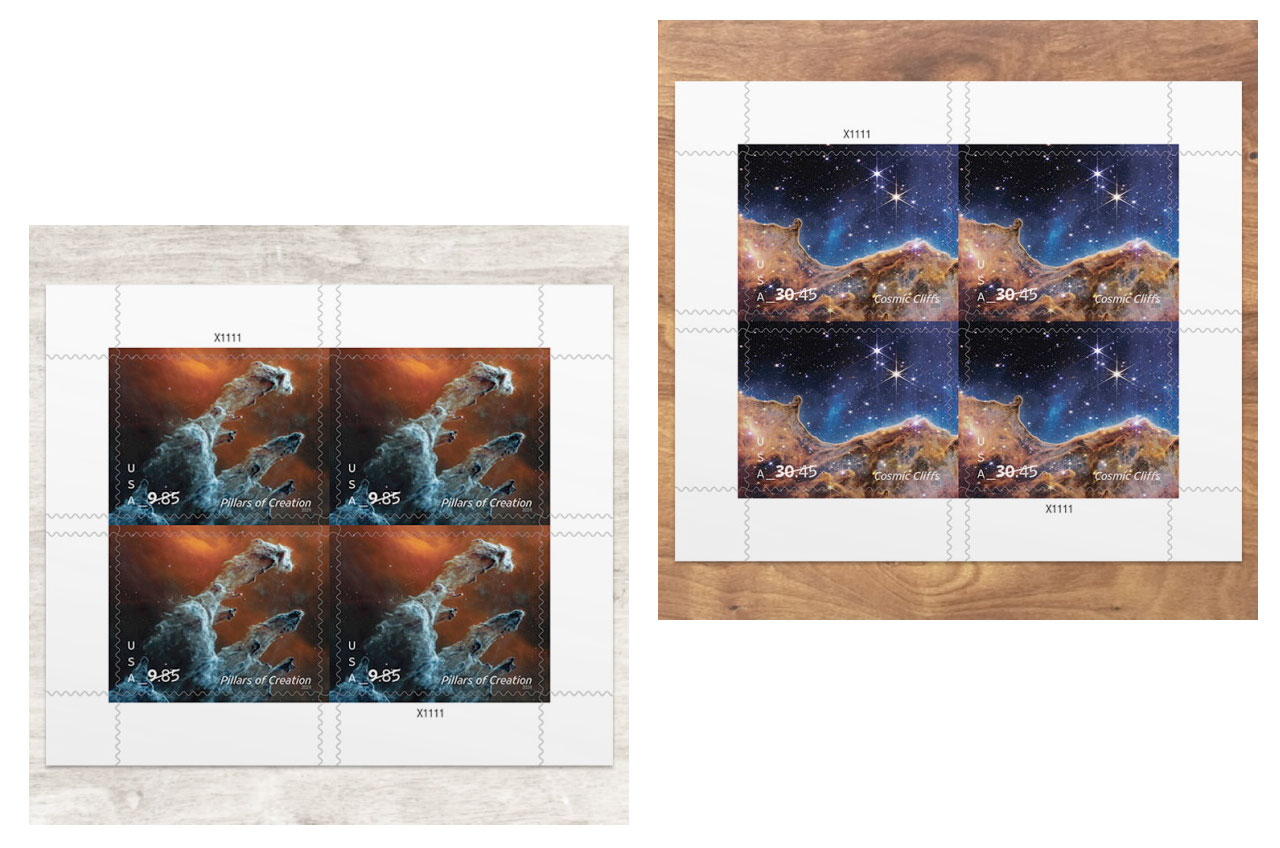US Priority Mail stamps now feature James Webb Space Telescope images
'Pillars of Creation' and 'Cosmic Cliffs' stamps are now available in panes of four stamps each.

As light reaching the James Webb Space Telescope, it took between 6,500 and 7,600 years for the "Pillars of Creation" and "Cosmic Cliffs" to be received. As the images on two new U.S. Priority and Priority Express-rate postage stamps, they will almost assuredly get your mail to its destination much sooner.
The United States Postal Service (USPS) released both stamps on Monday (Jan. 22). Although their official "first day of issue" city is Greenbelt, Maryland — home to NASA's Goddard Space Flight Center, which managed the James Webb Space Telescope's development — a traditional first of day issue ceremony was not held.
"Celebrate NASA's James Webb Space Telescope and its continued exploration of deep space," reads the USPS website about the new $9.85 "Pillars of Creation" Priority Mail stamp and $30.45 "Cosmic Cliffs" Priority Mail Express stamp. These exquisite images were "made possible by Webb."
Related: James Webb Space Telescope (JWST) — A complete guide
The Priority Mail stamp displays Webb's infrared view of the Eagle Nebula, providing an alternate look at one of the Hubble Space Telescope's most iconic visages. The Webb's version of the "Pillars of Creation" reveals a landscape otherwise invisible to the human eye.
"Why does mid-infrared light set such a somber, chilling mood in Webb's Mid-Infrared Instrument (MIRI) image? Interstellar dust cloaks the scene," reads NASA's caption for this version of the "Pillars" captured in 2022. "And while mid-infrared light specializes in detailing where dust is, the stars aren't bright enough at these wavelengths to appear. Instead, these looming, leaden-hued pillars of gas and dust gleam at their edges, hinting at the activity within."
"How vast is this landscape? Trace the topmost pillar, landing on the bright red star jutting out of its lower edge like a broomstick. This star and its dusty shroud are larger than the size of our entire solar system," NASA's description reads.
"Cosmic Cliffs," one of the Webb's first targets, adorns the Priority Mail Express stamp.
"Called the 'Cosmic Cliffs,' Webb's seemingly three-dimensional picture looks like craggy mountains on a moonlit evening," reads NASA's website. "In reality, it is the edge of the giant, gaseous cavity within [the Carina Nebula], and the tallest 'peaks' in this image are about 7 light-years high. The cavernous area has been carved from the nebula by the intense ultraviolet radiation and stellar winds from extremely massive, hot, young stars located in the center of the bubble, above the area shown in this image."
The USPS is selling both the "Pillars of Creation" and "Cosmic Cliffs" stamps in panes of four stamps each for $39.40 and $121.80, respectively.
Although there was no ceremony, the postal service is offering first-day covers — collectible envelopes affixed with either the Priority Mail or Priority Mail Express stamps and postmarked in Greenbelt, Maryland with Monday's date. There are two different cancellation devices as well: a standard circular date ink stamp with four "killer bars" and a digital color postmark in either blue for "Pillars" or orange for "Cliffs."
The first day of issue (black ink) covers cost $10.40 for Priority Mail and $31.00 for Priority Mail Express. The digital color covers are $11.25 and $31.85, respectively. First-day postmarks are also available for no more than a cost of a stamp (or two).
The public has the next 120 days to buy and affix the "Pillars" or "Cliffs" stamps (or both together) to an envelope or envelopes of their desire, self-address or address it to others and then mail it (them) inside a larger envelope to:
DOI Cosmic Cliffs Stamp or Pillars of Creation Stamp
USPS Stamp Fulfillment Services
8300 NE Underground Drive, Suite 300
Kansas City, MO 64144-9900
Breaking space news, the latest updates on rocket launches, skywatching events and more!
After applying the first-day-of-issue postmark, the USPS will return the envelope through the mail. There is no charge for the postmark up to a quantity of 50, after which it is 5 cents per additional postmark. All requests must be postmarked by May 22, 2024.
Collectors and the public can also send stamped envelopes and postcards without addresses for postmark, so long as they supply a larger self-addressed envelope with adequate postage. After applying the postmark, the post office will return the covers (with or without addresses) in the addressed larger envelope.
The 2024 Priority Mail and Priority Mail Express stamps mark the second time that the USPS has highlighted the James Webb Space Telescope on postage. In 2022, the postal service released a Forever denomination stamp featuring a rendering of what the Webb looked like after it entered service in deep space.
Follow collectSPACE.com on Facebook and on Twitter at @collectSPACE. Copyright 2024 collectSPACE.com. All rights reserved.
Join our Space Forums to keep talking space on the latest missions, night sky and more! And if you have a news tip, correction or comment, let us know at: community@space.com.

Robert Pearlman is a space historian, journalist and the founder and editor of collectSPACE.com, a daily news publication and community devoted to space history with a particular focus on how and where space exploration intersects with pop culture. Pearlman is also a contributing writer for Space.com and co-author of "Space Stations: The Art, Science, and Reality of Working in Space” published by Smithsonian Books in 2018.
In 2009, he was inducted into the U.S. Space Camp Hall of Fame in Huntsville, Alabama. In 2021, he was honored by the American Astronautical Society with the Ordway Award for Sustained Excellence in Spaceflight History. In 2023, the National Space Club Florida Committee recognized Pearlman with the Kolcum News and Communications Award for excellence in telling the space story along the Space Coast and throughout the world.


